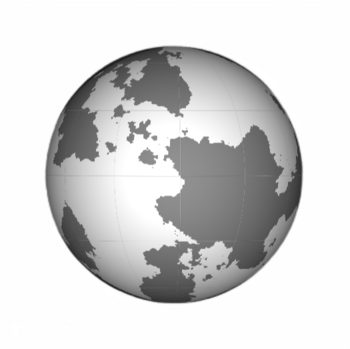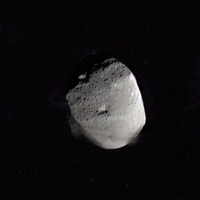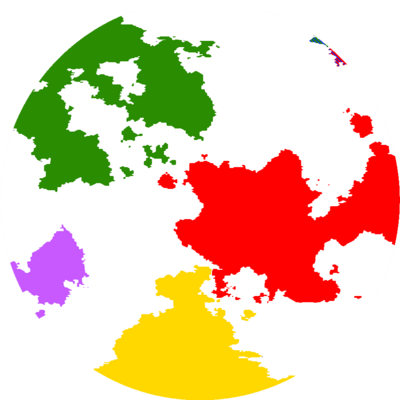Kelera
Kelera photo from orbit and scheme of the day side | |||||||||||||
| Designations | |||||||||||||
|---|---|---|---|---|---|---|---|---|---|---|---|---|---|
| Tau Lanus c, New Terra, The World | |||||||||||||
| Orbital characteristics | |||||||||||||
| 7479893.535 km (4647790.364 mi) (0.05 AU) | |||||||||||||
| Eccentricity | ~0 | ||||||||||||
| 14 d (2.0 weeks) | |||||||||||||
Average orbital speed | 29.78 km/s (18.50 mi/s) | ||||||||||||
| Satellites | Small natural satellit-asteroid: Erebus 500+ operational artificial satellites | ||||||||||||
| Physical characteristics | |||||||||||||
Mean radius | 7946.14 km (4937.50 mi) | ||||||||||||
| Circumference | 49.926 km (31.023 mi) | ||||||||||||
| 793.454.977km2 (306.354.679 mi2) | |||||||||||||
| Volume | 1.08321 × 1012km3 | ||||||||||||
| Mass | 14.4785168 x 1024 lb | ||||||||||||
Mean density | 4,59 g/cm3 | ||||||||||||
| 26.7 ft/s2 (0.83 G with respect to the earth's gravity) | |||||||||||||
| 0.3307 | |||||||||||||
| 11.186 km/s (6.951 mi/s) | |||||||||||||
Sidereal rotation period | ∞ (Tidal locking) | ||||||||||||
Equatorial rotation velocity | 0.4651 km/s (0.2890 mi/s) | ||||||||||||
| 0° | |||||||||||||
| Albedo | 0.367 geometric 0.306 Bond | ||||||||||||
| |||||||||||||
| Atmosphere | |||||||||||||
Surface pressure | 101.325 kPa (at MSL) | ||||||||||||
| Composition by volume | 78.08% nitrogen (N2) (dry air) 20.95% oxygen (O2) 0.930% argon 0.039% carbon dioxide (climate-variable) | ||||||||||||
Kelera, also known as Tau Lanus c, or The World, is the second planet from the Star Tau Lanus and makes a revolution around her in 14 days. This is one of the planets colonized by the humanity, and one of the few on which life has been discovered. Life before colonization on the planet was represented by simple microorganisms, algae, fungi and lichens. While large amounts of water can be found throughout the Tau Lanus System, only Kelera sustains liquid surface water. Oceans covers 31% of its surface on the day side. Most allmost all of its water is retained in on the dark side of the planet large polar sheets of ice, covering ocean and land, dwarfing groundwater, lakes, rivers and atmospheric water. Kelera's atmosphere is radically different from those of the other planets, having been altered by the presence of life to contain 19% free oxygen. The planetary magnetosphere shields the surface from cosmic radiation, limiting atmospheric stripping and maintaining habitability. However, her it one major difference - the planet is Tidal locking. As a result, the side constantly facing the star is a massive desert, while the side facing away from the star is a frozen land. However, in-between these extremes, there are rings of habitable areas with different climates depending on how warm they are. Planetary hurricanes regularly take place on the planet, which bring dust from the daytime side, and at other times the sky constantly remains pinkish or yellow-orange. Kelera has small natural satellit-asteroid named Erebus.
Satellit-asteroid Erebus
| As seen by Erebus from Kelera | |
| Diameter | 22.2 km |
| Mass | 10.7×1015 kg |
| Semi-major axis | 9,377 km |
| Orbital period | 7h 43.7m |
Kelera has one relatively small (compared to Earth's) natural moon, Erebus or Kelera 1 (about 22 kilometres (14 mi) in diameter), which orbit close to the planet. The origin of moon is unclear, although a popular theory states that were asteroid captured into Kelerian orbit. Erebus is a small, irregularly shaped object with a mean radius of 15 km (9,3 mi). Erebus orbits 6,000 km (3,700 mi) from the Kelerian surface, closer to its primary body than any other known planetary moon. From the surface of Kelera, the motions of Erebus appear different from that of the Earth's satellite, the Moon. Erebus rises in the west, sets in the east, and rises again in just 11 hours. Because the orbit of Erebus is below synchronous altitude, tidal forces from Kelera are gradually lowering its orbit. In about 50 million years, it could either crash into Kelera's surface or break up into a ring structure around the planet. If viewed from Kelera's surface near its equator, full Erebus looks about one-third as big as a full moon on Earth. Thus there are no total solar eclipses on Kelera, as the moon are far too small to completely cover the Tau Lanus.
Life on Kelera before colonization
The history of Kelera
Colonization
Geography
Continents
Kelera has an approximate total land area of 793 454 977 km2 (306 354 679 sq mi). The remaining 31% of its surface on the day side by water. Kelera's surface is customarily divided into four continents—Eslasia, Ayusmezia, Zlekizia, Giataendia—and three oceans: the Northern Foggy Ocean, Southwest Ocean, Small Southern Ocean. The continents can be divided into subcontinents, especially the large peninsulas separated from the main continental landmass by geographical and cultural features.
- Eslasia is Kelera's largest continent. It is located on day side and bounded by seas and oceans on all sides. Eslasia is the most diverse continent in Kelera, with biomes ranging from deserts to tundra to the tropics of the weastern coast where there is a the substellar point. In the center of the continent there is a large wasteland - a place that no one on the planet claims because of the difficult terrain with the highest and longest mountain ranges, changeable and harsh climate, with biomes ranging from deserts to tundra and lack of infrastructure. In the east of the continent is the subcontinent, which is called the "bridge to the twilight ice wall" due to the fact that it adjoins the glacier on the dark side of the planet.
- Ayusmezia is a continent located in the on day side, and in the Southern Hemispheres, of Kelera. The vast continent is bounded by the Southwest Ocean and Small Southern Oceans. A mountain range stretches from the west coast to the bottom of the east coast, followed by the south pole. In Ayusmesia, the climate is also harsh and changeable, with the exception of the upper peninsula with a stable temperate climate. Central Canal is an artificial waterway that connects the Southwest Ocean with the Small Southern Ocean and divides Eslasia and Ayusmezia.
- Zlekizia is a continent located in the on day side, and in the Northern Hemispheres, of Kelera. It is the second largest and most populous continent in the world. Zlekizia consists of an archipelago and several large peninsulas, the upper and lower of which are subdivided into subcontinents. The rest of the invisible part of the continent is located on the eternally night side of the planet and is covered with glaciers. The vast continent is bounded by the Southwestern Ocean and the Northern Foggy Ocean. Canal is an artificial waterway that connects two seas.
- Giataendia is a continent with a total area of 4.85 million square kilometers (1,870,000 square miles) is the smallest of the 4 continents and the second driest continent (after Eslasia) on Kelera. Giataendia bounded by the Southwest Ocean. Most of the invisible part of the continent is located on the eternally night side of the planet and is covered with glaciers.
Oceans
Kelera, like Earth, is a blue planet. The presence of water on its surface is unique in the Tau Lanus System. The main bodies of water in the hydrosphere are the oceans: the Northern Foggy Ocean, Southwest Ocean, Small Southern Ocean and several seas.
| # | Ocean | Location | Area (km2) |
% of the world ocean |
|---|---|---|---|---|
| 1 | Northern Foggy Ocean | Between Zlekizia and Eslasia | 49 634 000 | 46% |
| 2 | Southwest Ocean | Between Zlekizia and Ayusmezia and Giataendia | 34 528 000 | 32% |
| 3 | Small Southern Ocean | Between Eslasia and Ayusmezia | 22 659 000 | 21% |




